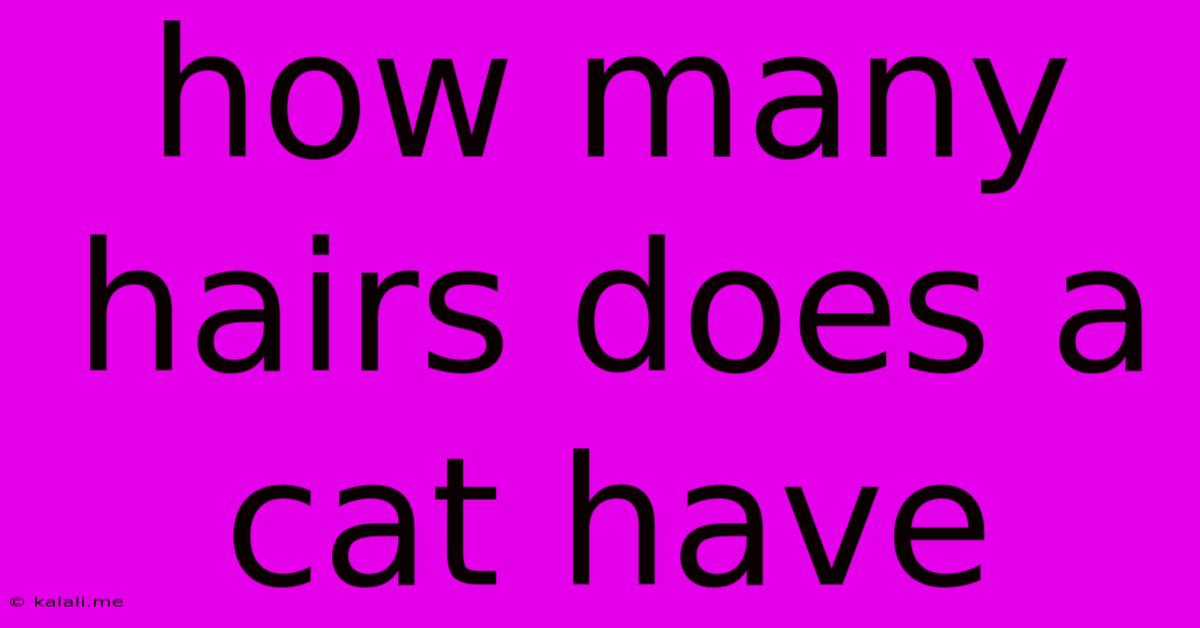How Many Hairs Does A Cat Have
Kalali
May 22, 2025 · 3 min read

Table of Contents
How Many Hairs Does a Cat Have? Unraveling the Feline Fur Enigma
Cats, with their sleek coats and mesmerizing purrs, are beloved companions worldwide. But have you ever wondered just how many hairs cover their velvety bodies? This seemingly simple question leads us down a fascinating path exploring feline anatomy, coat variations, and the science behind their impressive fur. This article will delve into the surprising answer and uncover some interesting facts about cat hair.
The Short Answer: There's No Single Number
Unfortunately, there isn't a definitive answer to "how many hairs does a cat have?" The number varies drastically depending on several factors:
-
Breed: Longhaired breeds like Persians and Maine Coons naturally possess significantly more hairs than shorthaired breeds like Siamese or Abyssinian cats. The length and density of the fur are key determining factors. Think of the difference between a thick winter coat and a light summer one – the principle is the same.
-
Size: Larger cats generally have more hairs than smaller cats. A Maine Coon will naturally boast a much higher hair count than a Singapura.
-
Age: Kittens typically have fewer hairs than adult cats, as their coats are still developing.
-
Coat Health: Cats experiencing hair loss due to illness, stress, or poor nutrition will have a lower hair count. Proper grooming and a healthy lifestyle contribute to a full and lustrous coat.
Estimating the Hair Count: A Scientific Approach
While we can't give an exact figure, scientists have attempted to estimate hair density in cats. Studies have focused on the number of hairs per square centimeter of skin. This approach provides a more manageable way to compare different breeds and coat types. However, even with this method, variations remain significant.
Beyond the Numbers: Understanding Feline Hair
Understanding the different types of cat hair is crucial. Cats have three primary types of hair:
-
Guard Hairs: These are the long, coarse outer hairs that protect the cat's skin from the elements. They provide the cat's coat with its overall texture and color.
-
Awns: These are slightly shorter and softer than guard hairs, contributing to the coat's overall thickness and insulation.
-
Down Hairs: These are the soft, fluffy undercoat hairs that provide insulation and warmth. They are much finer and more numerous than guard hairs and awns.
The relative proportions of these hair types drastically influence the overall hair count. Longhaired cats have a far greater proportion of down hairs compared to shorthaired cats.
The Importance of Feline Fur
A cat's coat is far more than just aesthetic appeal; it plays a vital role in their overall health and well-being:
-
Thermoregulation: The fur provides insulation, helping cats regulate their body temperature in both hot and cold environments.
-
Protection: The coat acts as a protective barrier against minor injuries and environmental irritants.
-
Camouflage: The coloration and patterning of a cat's fur can help them blend into their surroundings.
Conclusion: A Fuzzy Mystery Remains
While we can't pinpoint the exact number of hairs on a cat, the journey to understanding the complexities of feline fur reveals fascinating insights into their biology and adaptation. From breed variations to the intricacies of different hair types, the topic is a testament to the remarkable diversity and adaptation of our feline friends. Instead of focusing on a precise number, appreciating the beauty, function, and vital role of a cat's coat is far more rewarding.
Latest Posts
Latest Posts
-
How Many Sides Does The Circle Have
May 23, 2025
-
Power Automate One Flow To Handle Multiple Form Responses
May 23, 2025
-
Blender Stack Trace 0x000001cfa70a3e00 Symbols Not Available
May 23, 2025
-
5e Object Interaction To Swap Weapons
May 23, 2025
-
Novel About People Who Photosynthesize Sociology
May 23, 2025
Related Post
Thank you for visiting our website which covers about How Many Hairs Does A Cat Have . We hope the information provided has been useful to you. Feel free to contact us if you have any questions or need further assistance. See you next time and don't miss to bookmark.